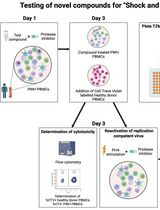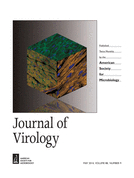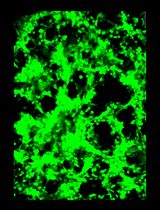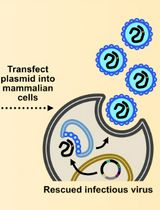- EN - English
- CN - 中文
Hepatitis C virus Cell-to-cell Spread Assay
丙型肝炎病毒在细胞之间的传播试验
发布: 2014年12月20日第4卷第24期 DOI: 10.21769/BioProtoc.1365 浏览次数: 11588
评审: Lee-Hwa TaiAnonymous reviewer(s)

相关实验方案

诱导型HIV-1库削减检测(HIVRRA):用于评估外周血单个核细胞中HIV-1潜伏库清除策略毒性与效力的快速敏感方法
Jade Jansen [...] Neeltje A. Kootstra
2025年07月20日 2395 阅读
Abstract
Hepatitis C virus (HCV) can infect naïve cells via entry of “cell-free” extracellular virus or direct “cell-to-cell” transmission. Here, we describe an assay for detecting HCV cell-to-cell transmission, using a non-growing cell culture system that avoids confounding effects of cell growth. The assay consists of infecting a small number of cells in a confluent monolayer and then blocking subsequent cell-free extracellular virions with a neutralizing antibody such that only cell-to-cell transmission may occur. Under these conditions, incubation at 37 °C results in the formation of infected cell foci. The extent of cell-to-cell spread can then be determined by counting the number of cells in each focus. The assay may be modified to assess the effects of inhibitors and/or specific cellular genes on cell-to-cell spread of HCV.
Part I. Main protocol: HCV cell-to-cell spread in non-dividing Huh7 cell cultures
Materials and Reagents
- Huh7 cells (from Dr. Francis Chisari, The Scripps Research Institute, La Jolla, CA) (Zhong et al., 2005)
- JFH-1 HCVcc (generated as previously described and quantified by limiting dilution titer assay) (Yu and Uprichard, 2010; Knipe and Howley, 2007)
Note: Other infectious HCVcc clones can be used as well.
- Dulbecco’s modified Eagle’s medium (DMEM) (Mediatech, catalog number: MT-10-013-CV )
- Fetal bovine serum (FBS) (Hyclone, catalog number: SH30910.03 )
- Penicillin, streptomycin, L-glutamine (Mediatech, catalog number: MT-30-009-CI )
- Dimethyl sulfoxide (DMSO) (Sigma-Aldrich, catalog number: D4540 )
- 1x PBS (Mediatech, catalog number: MT- 21-030-CV )
- Hydrogen peroxide (H2O2) (Thermo Fisher Scientific, catalog number: H325 )
- AEC detection substrate (BD Biosciences, catalog number: 551015 )
- Glycerol (Sigma-Aldrich, catalog number: G5516 )
- Ezetimibe (Sequoia Research Products, catalog number: SRP04000e ) prepared in DMSO at 20 mM
- Rabbit anti-human CLDN1 polyclonal antibody (Abcam, catalog number: ab63070 )
- Rabbit anti-human NPC1L1 polyclonal antibody (Santa Cruz, catalog number: sc-67236 )
- Human anti-HCV E2 monoclonal antibody MAb AR3A (from Dr. Mansun Law, The Scripps Research Institute, La Jolla, CA) (Law et al., 2008)
- Mouse anti-HCV NS5A 9E10 monoclonal antibody (from Dr. Charles Rice, Rockefeller University, New York, NY) (Lindenbach et al., 2005)
- HRP-conjugated goat anti-human (Thermo Fisher Scientific, catalog number: 31410 ), goat anti-mouse (Thermo Fisher Scientific, catalog number: 31430 ), and goat anti-rabbit (Thermo Fisher Scientific, catalog number: 31460 ).
- Mouse IgG (Santa Cruz, catalog number: sc-2025 ), rabbit IgG (Santa Cruz, catalog number: sc-2027 )
- Paraformaldehyde (PFA) (Sigma-Aldrich, catalog number: P6148 )
- Triton X-100 (Sigma-Aldrich, catalog number: T-8787 )
- Bovine serum albumin (BSA) (Sigma-Aldrich, catalog number: A9647 )
- Lipofectamine RNAiMAX transfection reagent (Life Technologies, catalog number: 13778 )
- OptiMEM (Life Technologies, InvitrogenTM, catalog number: 31985-070 )
- 50 ml centrifuge tubes (Dot Scientific, catalog number: 451-PG )
- Complete DMEM (cDMEM) (see Recipes)
Equipment
- 96-well BioCoat collagen-coated tissue culture plates (Corning, catalog number: 356698 )
- BioCoat collagen-coated T75 cm2 flask (Corning, catalog number: 356485 )
- Inverted microscope
- Hemocytometer
- 37 °C, 5% CO2 cell culture incubator
- Table top centrifuge (e.g. Sorvall, model: T6000D or Eppendorf, model: 5810 R )
Procedure
文章信息
版权信息
© 2014 The Authors; exclusive licensee Bio-protocol LLC.
如何引用
Barretto, N. and Uprichard, S. L. (2014). Hepatitis C virus Cell-to-cell Spread Assay. Bio-protocol 4(24): e1365. DOI: 10.21769/BioProtoc.1365.
分类
微生物学 > 微生物-宿主相互作用 > 病毒
微生物学 > 微生物细胞生物学 > 基于细胞的分析方法
细胞生物学 > 细胞信号传导 > 胁迫反应
您对这篇实验方法有问题吗?
在此处发布您的问题,我们将邀请本文作者来回答。同时,我们会将您的问题发布到Bio-protocol Exchange,以便寻求社区成员的帮助。
Share
Bluesky
X
Copy link











